We occasionally link to goods offered by vendors to help the reader find relevant products. Some of these may be affiliate based, meaning we earn small commissions (at no additional cost to you) if items are purchased. Here is more about what we do.
Are you trying to understand the ins and outs of copper cookware and choose the best product for your home? If so, this copper cookware guide will greatly assist you in picking a top notch product that will not let you down and may even last for generations.
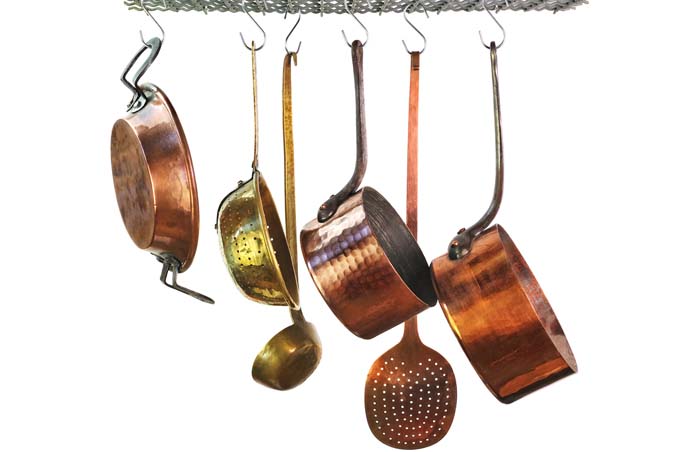
If cast iron is the king of cookware, then copper must be the queen.
However, in many ways this material is much more versatile than cast – in chess the queen can easily move in any direction as many squares as she wants while the king is stuck trudging along one square at a time.
This analogy holds true when comparing cast iron to copper construction. Your heavy iron pans have the ability to slowly heat up and then once at temperature, this heat spreads evenly throughout the body of the vessel.
If removed from the stove, cast iron pans will retain this heat for a very long time – making them ideal for serving up stews, pizzas, etc.
However, sometimes you want to be very nimble in your control of the temperature and this can be difficult with stainless and impossible with cast iron – particularly if using an electric range.
This is where a true copper skillet or pot shines – the ability to increase or decrease the temperature very quickly.
A second, and also very important part of copper’s superior cooking is it’s ability to spread out the heat to all parts of the pan evenly.
This may not be an issue if your cooking for yourself and don’t often use more than an 8 inch skillet, but if you are preparing food for two or more people, other materials often become painful to regulate – you end up constantly shifting the vessel to one side or the other and the heat is really only available in one spot on the cooking surface.
This is NOT the case with the better copper cookware products. Since this material is such a good conductor, the thermal energy easily travels to all parts of the bottom of the pan with a near equal distribution of temperature.
How does copper make cooking easier?
Copper is one of most highly sensitive elements to conduction of heat – just shy to that of silver and gold (and who can afford an entire silver cooking set?). It ability to heat evenly makes sticking on a non-teflon coated pan mostly a thing of the past.
Since sticking is often from the results of hot spots on the pan, the ability of this material to eliminate temperature fluctuations greatly reduces the chance that this will occur.
Moreover, this metal is one of the most energy efficient materials and will save you energy throughout its lifespan (which will probably last multiple generations if well cared for).
This ability to spread heat evenly is most noticeable when you’re preparing entrées that are burn easily or rather delicate in composition.
It is particularly advantageous if you’re like me and have multiple items cooking at the same time and don’t normally focus on a particular dish. Even temperature control can be critical for some procedures, but of minimal importance for other tasks.
When you are boiling hot water, for instance, keeping an even temperature across the bottom of the pan makes no difference.
Conversely, When you are steaming dairy products, unequal temperatures along the pot’s bottom can readily lead to scalded milk or gooey parts if you do not stir continuously.
What’s more, you’ll see noticeable enhancements in the course of daily cooking projects.
For instance, say you are simply sautéing onions in butter, but get a little rushed, and you crank up the temperature.
If you were using a skillet with inferior heat dispersion, such as in pure stainless examples, you will need to be mindful to ensure the onions do not burn or stick to the bottom as a result of hot spots.
In a good copper pan, providing you do not turn the temperature up excessively high, it is a good deal harder to get things to burn or stick to the bottom.
If you’re a one dish at time chef, then copper may lose some of its advantages as you can simply keeping stirring or flipping to stop things from sticking or burning.
Of course if you don’t mind Teflon coated pots and pans, this benefit may be a moot point as well.
Characteristics of the Best Copper Pots and Pans
Thickness
In most cookware, the thicker the material it is made from, the better. When ordering a pan or a complete set, don’t assume that all examples are of similar quality and of the same thickness. You should check on the exact weight of the item and ask about how thick the copper actually is. Some manufacturers tend to obfuscate this question and others are more forth coming.
Typically it is best to avoid products made in Portugal – notably the Copral and Tagus brand names – as these tend to be very thin – 1.5mm or thinner. This thinness issue even extends to some of the better makers who also make lower price sets such as this example from the Mauviel Presentation Line shown below. You should always look to find products that are at least 2mm thick or thicker and 2.5mm thick is where you hit the golden spot in terms of performance vs price.
In general, the thinner pieces will have bronze handles such as the Mauviel’s Presentation line as previously mentioned and thicker pieces will feature cast iron handles or stainless steel handles such as those found on Mauviel’s M’Heritiage line shown below. This is not set in stone, however and you’ll find a few aberrations to this identification technique – especially with older examples made in Villediue, France. At one time there were many makers in this village and many of them experimented or offered various handle combinations.

A saucepan features 2.5mm thick metal from Mauviel’s M250C line.
Additionally, you should steer clear of any kind of cooking vessel that has a rolled edged.
If the metal is thin enough to roll, it is much too thin to serve as cooking platform and these should be confined to decorator duties or to boil water in at the most.
Appearance – Hammered vs Smooth
Copper cooking vessels are available in both a smooth and “hammered” finish. At one time, the hammered look meant a guarantee of handcraftsmanship.
However, nowadays almost all examples are made with machines and the hammered appearance is really a decision based on your aesthetic preferences and availability of finish choices in the particular pot or brand that you are interested in.
A smooth finish will be much more common throughout most of the decent quality brands, although most manufacturers do offer some pieces in both finishes.
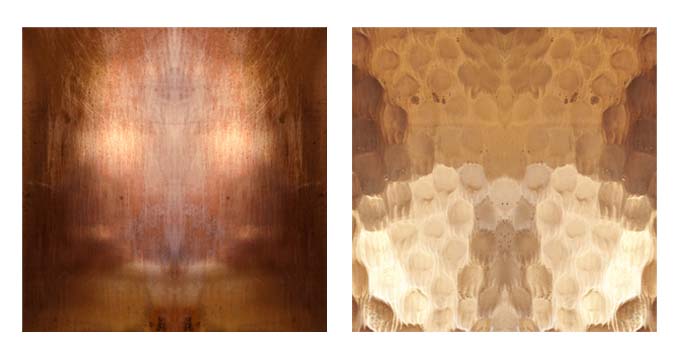 Smooth Vs. hammered finish
Smooth Vs. hammered finish
The hammered finish is also not indicative of any quality indicator as cheap display pieces also feature this pattern as well (if not more so) although some high quality hand made artisan shops still exist.
Sertodo Alicante Paella Pan, 15 inch diameter, Hammered Copper with Stainless Steel handles available from Amazon
The 15″ Sertodo Alicante Paella Pan shown above is great example of a hammer finish on copper cookware. Side note – this thing is massive, and it features a traditional tin finish. According to the manufacturer’s website, “Each Sertodo Copper piece is individually handcrafted by autonomous artisans in Santa Clara del Cobre, a village located high in the Sierra Madres Occidental of Southwestern Mexico.”
I really, really want this but I haven’t been able to justify it as of yet. I’ve got other pans that can do the same thing for the few times a year I need a paella pan with this much room.
If I didn’t have (many) other similar pans (albeit in stainless), the Sertodo Alicante would top my “must have” list.
Tin Vs. Stainless Linings in Copper Cookware
Copper cookware is available in three different material configurations – bare, tinned, and stainless steel lined.
There are some serious misconceptions and (somewhat blatant) truth stretching on the net about the advantages and disadvantages of each these materials.
I’m writing this post to hopefully shed some light on the facts; however, please understand this is my opinion and I am not the goddess of copper – please leave your opinion and knowledge in the comment area at the bottom so we can all share our culinary knowledge.

Bare
Bare copper is the most inexpensive and for most tasks, the least desirable. Although this metal is an excellent conductor of heat, in its uncoated form has serious reactions with acidic foods such as tomatoes and various vinegar based dishes.
Moreover, in large quantities copper can be hazardous to your health (but it is also a required mineral for your body so don’t be afraid to use it occasionally).
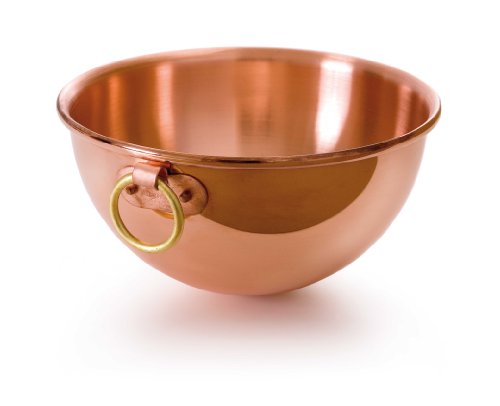
Mauviel M’Passion 4.9-Quart Egg White Bowl
That being said, bare metal does have a few excellent advantages and you may want to have one or two pieces in your arsenal.
One of the most common uses for these unlined products includes the whipping of egg whites for the creation of meringues and other similar such dishes.
A bare copper round bottom bowl, such as the Mauviel M’Passion 10-InchEgg White Bowl, available at Amazon ,works very well for this procedure as the metal reacts with the egg whites allowing them to retain more air and “peak” much more quickly than what you would find to be the norm with a glass or stainless bowl.
Usually, crème of tartar is added to assist with the whipping process but with a copper bowl, this extra ingredient is no longer required.
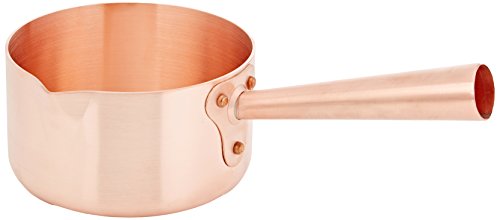
Mauviel Made M’Passion 1.9-Quart Sugar Saucepan
A small bare pot is also handy for making hard candy and melting sugar is another great piece to have if you are into this kind of cooking. One such example is this small sugar pan from Mauviel.
Jam pans are also traditionally unlined as sugar nullifies the effects of any acidic action on the bare matal.
Tin Lined
Almost no material conducts heat like copper – not cast iron, not aluminum, not ceramic or porcelain, nor glass, and definitely not stainless steel.
However, as I have noted, cooking on a bare pan is really not an option for most applications unless you happen to a Babylonian or a Phoenician.
Advantages and Benefits
Copper enhances home food preparation by allowing a fast responsive time from the heat source to the food.
However, an excessive amount of one thing is rarely healthy. Even though the antibacterial ability of this metal was identified thousands of years ago (although of course they did not know about bacteria – it just helped to keep the water “good”, so has the understanding an abundance of this element can lead to toxicity.
To avoid copper accumulation in the body, cooking equipment made with this this material has been coated with an inside layer of tin for hundreds of years.
This tin coating by no means interferes with the metal’s capacity to conduct heat; it merely prevents the copper from leeching into the food and into your gut.
Here’s the thing:
There are some notable benefits to using this time tested lining. Tin has natural crystalline structure that is very smooth with very few irregularities which means that it is naturally nonstick.
In fact, the only material that surpasses this material is the dreaded Teflon – and who wants that in their body?
Also, tin requires no seasoning as in the case of bare cast iron and it is also good for cooking high acid foods such as tomato based dishes unlike cast or steel.
Moreover, tin is a very good conductor of heat in its own right. You’ll be surprised by how quickly it heats and will probably have to turn down your burner the first couple of times you cook with it.
You definitely don’t need wok like temperature with this material!
No matter what kind of stove that you use, with the exception of induction (more on that later), all of the thermal energy will be applied to the food instead of being reflected of the bottom of the pan such as is the case with stainless steel or being absorbed by it as is the case with cast iron cooking implements.
The best thing about tin is that it is molecularly and chemically inert – it doesn’t respond to differences in pH and it does not impart either flavor or leave chemical substances into your food.
It isn’t hydrophilic like Teflon meaning that it doesn’t create a layer of water between substances that are cooking and the pan.
This is important to you because it allows you to fully brown meats and proteins unlike when cooking in a Teflon coated pan.

Ruffoni Protagonista/Basics 9-Piece Tinned Lined Set in Wooden Box, available at Amazon
Tin gradually oxidizes under high temperature and turns a little darker with age and use.
It passes along trace amounts of tin oxides into you meals similar to the way cast iron passes along iron oxides and this is a good thing.
Tin is an important nutrient that, in trace amounts, prevents fatigue and depression.
Think you are getting a little tin in your canned foods? Think again – 93% of all tinned canned are coated with a bisphenol A-based plastic which is NOT good for you.
Disadavantages
The layer of tin on even the better brands of copper cooking vessels can wear out. How soon that occurs depends on their use and care. Some of the pots and pans in busy commercial kitchens (think successful high end restaurant and five star hotels) may need retinning every year.
However, the average home cook, who prepares most of the family meals, may need a new coating reapplied every fifteen to thirty years or so. Since tin can be reapplied this also means that any scratches to the surface may be easily repaired by a professional.
Finding a craftsman that can reapply the tin can be a little challenging these days since most of society has evolved into a throw away mindset where buying a replacement is more often the case than performing repair work.
However, there are a couple of places in the US that still specialize in this unique art form.
Similar to Teflon, using your metal utensils with tin is definitely a no-no. They can scratch the lining as tin is a much softer material than steel.
Plastic or wood is your only good option for spatulas, spoons, etc.
Also, you definitely cannot use high temperature cooking methods with this type of lining. Tin starts to melt at 450 degree although a significant quantity of food in the pan can act as heat sink and allow a slightly higher temperature but you don’t want to regular boil a tin lined pan or pot dry on a habitual basis.
That being said, tin is not such a soft material that you should be afraid to regular use it as some on the net have tried to make it out to be.
In a nutshell, most of the commotion on the internet regarding tin and its fragility is has been blown out of proportion.
Steer clear of steel utensils, don’t scrub it with steel wool, green scratchies, or abrasives, and to never allow it to go unfilled on lit or powered burner/heating element.
Treat is just as would Teflon and you will be good to go for many, many years. For many tasks, such as those performed by a sauté pan, tin it is my preferred coating.
Stainless Lined
Stainless may be the better alternative lining for home cooking for most modern families and it is definitely the most popular in many of the better modern copper cookware lines.
Newer, better quality tin lined pans are being slowly phased out by many makers (which is a shame because they’re my favorite for certain applications).

Mauviel M’heritage M250C 9-piece 2.5mm Copper Cookware Set with stainless interior lining
The “tin only” crowd (most of whom have an agenda) will be quick to advise you that the stainless steel lining will negate the benefits as it will block much of the heat transfer.
This blatantly untrue – the stainless liner is so thin that the stainless steel will make no perceptible difference to the amount of heat that permeates through the bottom of the pan.
We’re talking factions of a degree given two equally sized vessels containing the exact same ingredients in the exact same proportion with the exact same heat source applied.
Advantages
Stainless steel does not rust, tarnish, or otherwise discolor. It does not easily scratch, ding, or oxidized.
It derives these properties from mixing nickel, chromium, and other lustrous metals (depending on the exact alloy) with steel which produces a very hard surface that is nearly indestructible with ordinary use.
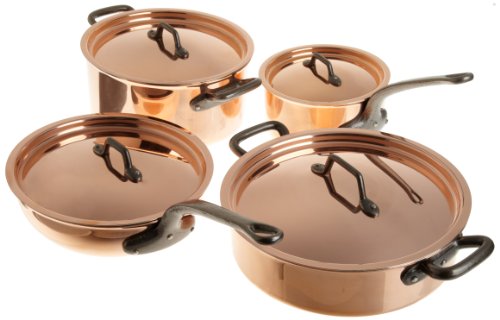
Matfer Bourgeat 915901 8 Piece Copper Cookware Set with stainless interior
No special cleaning agents or techniques are needed and the cookware may be able to be ran through the dishwasher (always follow manufacturers’ guidance with this). Green scratch pads, steel wool (on the inside) are all good to go with this lining material.
Slightly higher temperatures are also allowed when using stainless lined copper cookware – although you will often find that you really don’t need to turn up your temperatures any higher than that used by the tin lined products.
This higher temperature will let you properly sear steak but I really don’t like using my copper for this task – this is where unlined cast iron shines.
Disadvantages
Even the best stainless steel lined copper pan does not have the nonstick capabilities as those found in tin lined examples or properly seasoned cast iron.
Since, at a molecular level, the surface of stainless is rough and uneven, food tends to stick to it much more than that of a surface such as tin where it is much more “ordered” and smoother.
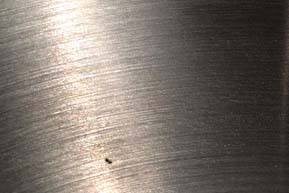 Pitting can also be a concern with stainless liners – especially when exposed to foods with high salt concentrations.
Pitting can also be a concern with stainless liners – especially when exposed to foods with high salt concentrations.
This salt can eat at the iron in the stainless and can form pin sized dimples in the surface. The photo to the left shows close-up of one of these pits.
Generally, these pin holes are of little concern as they do not penetrate very far into the coating. It is best to quickly wash your pans after cooking to avoid this.
Please note that pitting can be an issue with all forms of stainless cookware – it is not a copper only issue. It is not a common problem but it can happen.
Should the pits continue to grow (and most don’t) and deepen, this could lead to a separation of the stainless liner from the copper bottom as the liquids start making their way between the steel and the copper and cause the line to “lift.”
Repeated use of very high heat can also cause a separation.
Once separation has began, there is no repair – the pan is toast. Again, this condition is very rare and should not stop you from making a purchase. With proper care, you should have no issues.
Induction Cooking
Although using these high quality pot and pans are one of my favorite ways to prepare awesome food for my family, friends, and guests, they are not without their limitations.
They do need some special care when it comes to cleaning and using (no metal utensils on the tinned versions).
However, their biggest limitation is that they, for the most part, do not have the ability to operate on an induction type range.
Induction requires a magnetic type of material work it’s magic and since copper is not able to react with magnets, they cannot be used straight on an induction stove.
There are iron or steel adapter plates available that allow the use of non-magnetic surfaces but they can be clunky.
However, one manufacturer has developed a copper line that includes a built in plate that is able to respond to an induction service.
This is de Buyer’s Prima Matera collection and we have conducted an extensive review and definitely have some good things to say about the products.
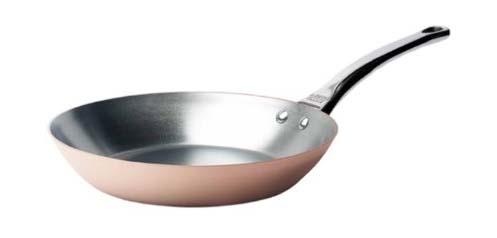
A frying pan from de Buyer’s Prima Matera Line that allows for cooking on induction ranges.
Recommendations
If you’ve made it this far, you may be wanting a few recommendations of what I believe to be the best copper cookware for your home is hat is currently on the market.
Some folks like “sets” and others don’t give a hoot. Personally, I’m in a the “don’t give a hoot” camp and like the best tool for the job.
I also like the visual appearance of an eclectic set of cooking vessels to decorate my walls, shelves, and racks.
Individual Pieces
Each piece of copper cookware that is in my collection is as of a high as a quality that I could afford at the time – I’m not rich enough to afford poor tools and I don’t wish to “update” or start anew every so often.
Every piece that I’ve purchased for my home was chosen with a purpose and I’m about to let you in on those selections that I’ve found useful throughout the years and which are still on the market today.
I will cover some individual pieces that I believe should be the cornerstone in any assemblage and in a separate post, I will write about a few copper cookware sets in case you want to keep the same appearance throughout your collection.
The Roundeu
An agreement could easily be made that the corner stone of any copper cookware collection, especially if you do allot of cooking in the French Style, would be the Roundeu. I use one of these nearly as much as I do a frying pan.
The copper rondeau is a broad bottomed, (usually) very heavy pot having straight sides. It feature two loop type handles as you are not going to do much flipping with one of these battleships!
Bistro and other culinary chefs regularly utilize rondeaus, not just the huge volume but also for their amazing flexibility.
A rondeau is a “catch all” vessel. By using it, you can utilize just about any food preparation method to include, but not limited to, braising, roasting, deep and shallow frying, searing, and simmering.
Since these are such large pans, and you have the ability to fit, multiple chickens and such in some of the larger ones, it only makes sense to get one of these, if your budget allows, with good copper construction from an excellent maker.

Mauviel M’Heritage Copper 150s 6130.29 5.8-Quart Rondeau with Lid and Cast Stainless Steel Handle
I can easily recommend the Mauviel’s M’Heritage 5.8-Quart Rondeau with stainless liner, available from Amazon. It is a bit thinner than I normally advise (1.5mm) but this is such a large pan, you may want to make some allowances to lighten the load if you’re older or slight of build.
Loaded up, this pan can get quite heavy.
If you want something a little heavier in this class (2mm) that is stainless lined, it is very hard to go wrong with the Bourgeat 11″ “Suate” Pan.
Please note that this is really a Rondeau but I suspect the marketing department at Matfer Bourgeat figured that most folks in the US have no idea what a Rondeau is so they elected to call it the next closest thing, and more importantly, commonly known term for marketing purposes.
With that being said, this pan has got to be one of my favorites and one of the ones that I happen to own and use every day.
Bourgeat 11 in Copper Saute Pan Brazier available at Amazon
The Frying Pan and the Sauté
A frying pan or a sauté is arguably next most important pan to acquire in your collection. Without going into too much detail (I’m saving it for a future post), a sauté is has straight sides and a frying pan has sloping sides.
Ironically, the frying pan is a lot better at sautéing than the sauté pan. The sloping sides allow for better shaking and flipping of the food being prepared.
The straight sided sauté on the other and, is much better at frying a larger amount of food when comparing the exact same diameter of pan.
That is because the Sauté’s straight sides gives it about a 30% larger area that the food can rest on as it is being cooked.
The sauté’s straight sides allow it to better contain liquids with less spillage making it ideal for frying Chicken in the US style (with oil about half the way up the sides) and for making a moderate amount of sauces and gravy.
I’d suggest that starting out, if you buy a rondeau or a sauce pan, then pick the frying pan.
However, if you a just going to get one piece and want one pan for many applications, then the sauté makes allot of sense.
I’d like to throw out a massive tinned frying pan example here – a skillet, sauté pan, or a frying pan will be your highest payoff if you wish to explore tin linings (and some don’t) do to this material’s nonstick qualities and awesome temperature control.

Ruffoni 14″ Protagonista Frying Pan
This is the Ruffoni 14 inch Protagonista Frying Pan and is avaliable from Amazon. The massive pan is 14″ of goodness and has a really good amount of thickness at 2 – 2.5 mm (dependant on where you measure – the curved areas are a bit thinner do to stretching of the metal as it is shaped).
Ruffoni is hand made in Italy by craftsmen who still hammer out the copper body with old fashioned skill and technique.
I don’t yet own one of these yachts, but this thick Ruffoni is very high on my “want” list. I drool over the pictures the way kids (eh gad! I’m showing my age here) used to drool over pictures in the Sears catalogue!
Ruffoni also has some other thick tin lined vessels available in the their Protagonista line such a Paella pans, sauces pans, and they even offer a complete set. I would, however, avoid Ruffoni’s Historia Decor Line as it is on the thin side of being serviceable at 1.0 to 1.5mms in thickness.
If you are interested in one of the best quality stainless lined copper sauté pans and you love the traditional look of French cookware, then you can’t really go wrong with the offerings from Mauviel’s M250C line.
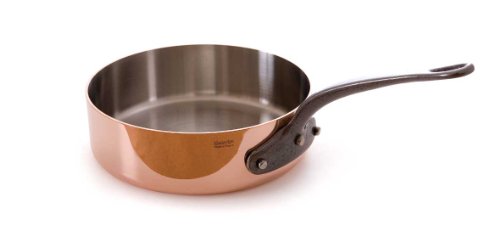
The Mauviel M’Heritage Copper 250c 4.9-Quart Saute Pan
The Saucepan
A saucepan is normally a smaller pot that is used for making (or finishing off) your sauces and gravies.
However, there is no 100% categorical definition to any of these pieces as you can also use these vessels to serve sautéing, cooking, and reheating duties and are the larger examples are often the prime candidates to prepare potatoes, rice, and pastas.
You can also use the largest examples to serve as your primary “stew” pot if are without a Roundeu or smaller stockpot. I’d suggest that you start with a larger one such as this M250C Mauviel pot and work you way down from there.
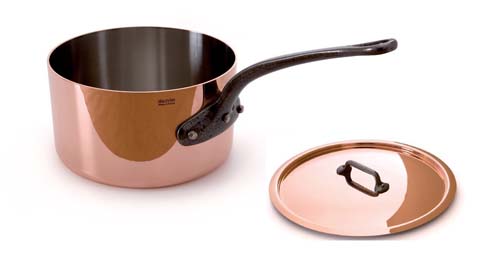
Mauviel M’Heritage Copper M250C 6501.19 2.5-Quart Saucepan with Lid, Cast Iron Handle
Like most modern Mauviel pieces, this one features a top of the line stainless interior as well as a cast iron handle that generally stays cool to the touch as compared to the bronze versions found on the cheaper lines.
The 2.5 cm thick copper ensures that the heat is transmitted evenly across the bottom to ensure that no sticking occurs on the surface and the continuous copper sidewalls allows for a great deal of that thermal energy to travel up the sides of the vessel and into your food.
Another variation that you may be interested in is the splayed “Windsor” style sauté/saucepan. These examples have really one purpose but they do it very very well – that is to reduce sauces and gravies.
Since the heat is concentrate at the bottom and then rises towards the wider top, the extra surface are allows for a greater and faster rate of evaporation allowing a sauce to “reduce” much quicker and lock in the flavors of the ingredients.
An excellent piece for any cook who performs allot reductions, curd making, or prepares any other recipes where a fast evaporation rate is encouraged.
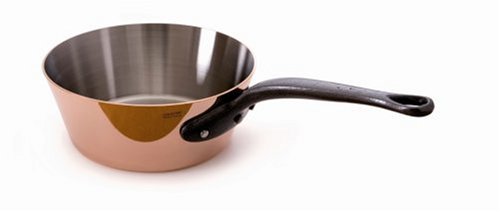
Mauviel M’Heritage Copper M250C 6503.20 1.7-Quart Splayed Saute Pan, Cast Iron Handle available from Amazon
A 1.7-Quart example of the Winsdor/Splayed style is shown above but these are available in several different sizes.
The Oddballs
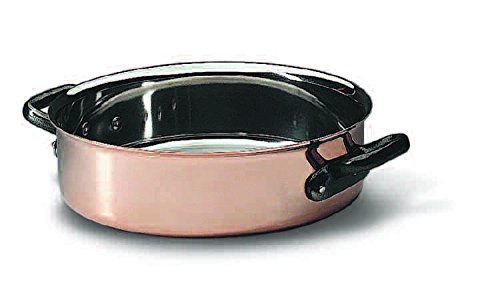
Bourgeat Copper 11″ Heave Sauté Pan
This Borgeat “Heavy Duty Sauté Pan” would make an excellent “catch all” as it seams to be a nice mixture of sauté pan, roundeu, saucepan, and stewpot – it’s the quintessential “pot” that could become the anchor in any no holds barred home kitchen.
I’m not sure why Borgeat called it a sauté pan – it really isn’t one – the best classification would be a brasier as it excels in braising and pot roasting – that is searing and then adding water, wine, or other liquids to finish cooking.
This pan is also available through Amazon.
There is one thing to note about the Borgeat Heavy Duty Saute Pan. At first this piece seems cheaper than the similar offerings by Mauviel and other makers.
There is, however, a small catch – if you want a lid then you have to purchase it separately and it’s not cheap.
Historically, this was actually the way most French copper was sold – lids were separate.
Conclusion
I hope this article any enlightened your on the pros and cons of copper cookware and that you can see the benefits that they bring to the table for the serious home chef.
At first the prices may send your heart into palpitations but you may want to think about the long term – a costly piece of cookware that will last a lifetime (and perhaps several lifetimes) and that brings you a whole lot of enjoyment isn’t really that expensive when itemized across decades of service.
About Lynne Jaques
Lynne is a stay-at-home mother of two boys. As a former US military officer and the spouse of an active duty US military member, Lynne enjoys traveling the world (although not the moving part!) and finding new cuisine and methods of preparing food. She also has the habit of using parenthesis way too much!

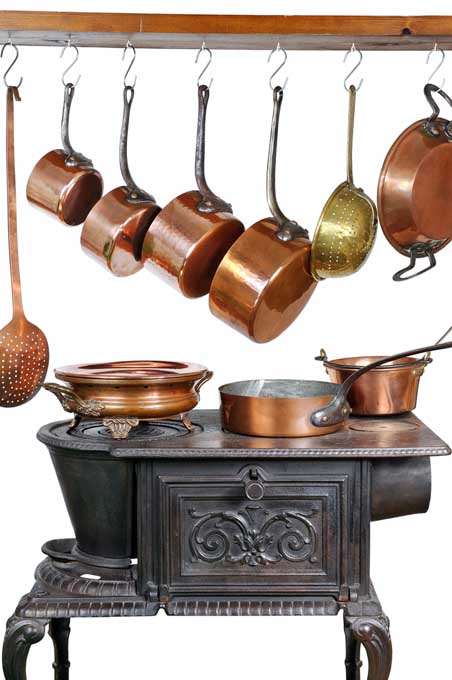
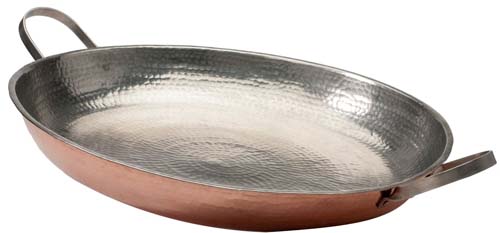
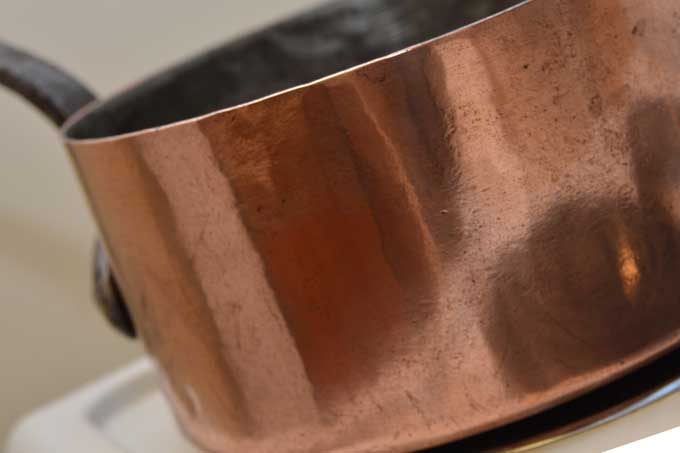
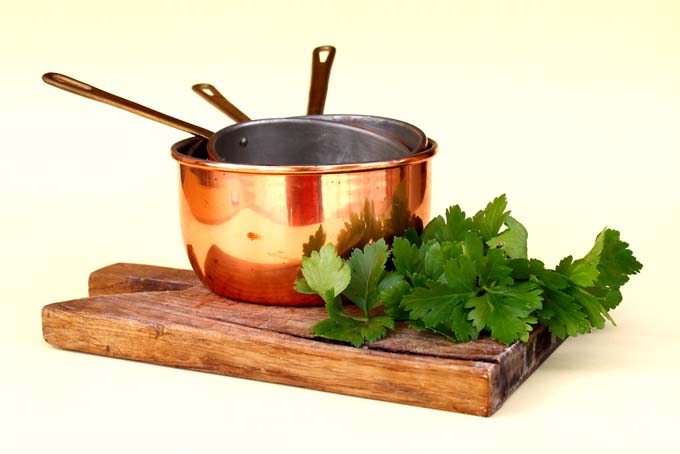

Great article. I’ve been thinking about getting a set of these for some time now and your article may have just nudged me over the edge. What are your thoughts about Faulk vs Bourgeat vs Mauviel vs the others? Quality wise and price wise? I’d appreciate any advice that you can give me.
Thanks
Uvone
Uvone,
I’m preparing an article that compares these three as they are the most commonly available brands in the North American market. I should have it post this week. Sign up for my newsletter and you’ll know straight away as soon as I’ve posted it. Hopefully, it will answer all of your questions.
Cheers
Lynne
I want to follow your recommendation and buy the https://www.amazon.com/Ruffoni-Protagonista-Basics-9-Piece-Cookware/dp/B005Z497WI?tag=foodal02-20 for my wife for Christjmas, but it’s out of stock on Amazon and I can’t find it anywhere! Please advise where I can find it. Thanks!
My family had a couple of bare metal copper pots when I was younger. I remember making jams and candies with these.
I can use a frying pan like the Ruffoni 14″ Protagonista Frying Pan, the double handles would allow more creativity for me.
Great article! I have been researching and getting all kinds of theories. This made a lot of sense and was very informative. Thank you. I am glad I googled it and found this site too. It is right down my alley. I look forward to more articles.
hi lynne. i found your article useful, as i had found a small copper fry pan second hand which seemed a little dubious, hence how i got to your article. i just wanted to call yuor attention to a typo: in the section on hammered vs. smooth, you refer to a cook’s “atheistic preferences” when i think you mean aesthetic preferences. that’s all i got. i look forward to reading more of your work. stevec
I’ve never used cooper cookware in my life, never felt the need for it. After this article I think it would be safe to assume that I need to get some investments done in my kitchen. I’ll consider copper cookware in the future, thank you for the tips! 🙂
Go to Belgium, visit the Falk factory, and watch your stainless-steel lined copper (2.5 mm) pans /lids being made. Nothing like it.
I live in the Netherland…I’m thinking a trip to the Falk Factory is required if I’m already looking at a $800 investment! Thanks for the tip!
I am wondering where in Canada you can get Tagus copper pans retinned — I am not sure it is worth it but
would like to check it out before I decide to pitch them out!
I found your post so informative, thank you for writing it!
I’m brand new to copper cookware, and wondered how bad a Mauviel M’hereitage 150S frying pan is? I know that it’s a bit thinner but it’s so much cheaper for an 11.8″ frying pan. Will I regret going with the thinner model?
I do loads of cooking, since I have a big family.
I bought a William Sonoma copper pan with a stainless interior. It was not very expenisve, but I was very soured by the fact that the inside and outside both tarnished after my first use, and careful washing. The stainless inside looked very old, so I returned it.
I don’t want to make the same mistake with my new pan.
Rikki
Great article…so helpful. How do you feel about copper utensils…such as a whisk? Would this combined with an unlined copper bowl help me with making meringue? Or is the whisk unneccesary?
Why do you say don’t get pans with rolled rims when Bourgeat’s rims are rolled?
Holly, I suspect that Lynne recommended not to get products with rolled rims as they are generally thinner. It’s pretty hard to roll a rim on thicker material. That being said, I doubt Mafter Bourgeat’s pans are thin. I don’t have one at my location and they don’t list the thickness on their site. We’ve sent an inquiry to them requesting thickness dimensions to verify if we still want to recommend them. Bourgeat makes some very high quality products so I suspect the thickness will be adequate or better. I’ll post their reply here.
Thanks
Mike Quinn
Foodal’s Chief Content Officer
Rolled pans have thin copper that is rolled over a round metal hoop at the top. Thicker copper pans often have the top edge flared and not rolled. Paul
Thanks you so much for all this great, detailed info!!
Thanks for all the info., I have a set of tinned pans, including a sauteuse, a sauté pan and 3 others of various sizes, the sauté pan us in need of retinning. I’ve had no luck in finding a company to do the work, I’m in Canada, any help would be appreciated.
A tip I’d like to pass on:- in the ‘old days’ we cooked. Green vegetables in raw copper bowls, the result being that the veg would finish with a beautiful green colour. Not having a copper bowl these days, I throw a couple of pennies into the salted water. You will be amazed st the difference this makes to the cooked product
I got my coppers retinned by an artisan that is named Les Étains Chaudron
He is in Val David Qc
He is a nice guy and works well
[Ed note: contact info removed to protect privacy]
Hello Lynne,
I was looking for info about my Baumalu copper pan and found your article. the pan is tin coated and some minor scratches, but some of them look pinkish so perhaps tin coating is damaged and copper exposed. According to your article, if I don’t cook acidic food it should be ok to use? I am not sure if you’ll see this, but if you do could you please let me know if the pan is safe to use?
thanks,
li
Hi Li,
This should be safe to use, though you’ll want to avoid cooking acidic foods in any pots with exposed copper. Retinning the pan is your best option- you can find professional services that will do this for a fee, or try your hand at DIY retinning.
Lynne,
How do I sign up for your newsletter
Hi Tywan,
We’re not currently producing a newsletter, but this is something that we’re working on- and we’ll be sure to keep you in the loop! In the meantime, please check out our podcast and visit us on Facebook, Twitter, Instagram, YouTube, and Pinterest.
Thank you Lynne for all this helpful information. I am totally new to the art of cooking with copper pans. Can you advise me on one to purchase for making carmel and toffee candy?
Thank you, Lisa
Hi Lisa,
This type of pan can be great for candymaking- just make sure you purchase an unlined pan (not tinned or otherwise coated) since cooking caramel is done over particularly high heat. And make sure the pan is super clean before you start the cooking process. Have fun!
Lynne, you are incorrect in stating that the Sertodo Alicante is made in Italy . It is made in Mexico and USA. If you read this email, today being 2/13/2017, it is on sale at Wayfair for $179.00. I almost ordered one but have an 18 and 32 inch Garcima Pata negra ( double thickness restaurant quality paella pan). I now have so called copper fever. When I stumbled on to a Havard villenieu 1940 hand hammered Rondeau pan with cast iron handles. I decided I can do without the Sertodo Alicante pan. Anyway, when I make paella, I invite friends to join. Enjoy your article.
Thanks, C. Good catch- this pan was handmade in Mexico. We have updated our review.
Wishing you the best of luck with your copper fever, enjoy the paella, and keep coming back to Foodal for kitchen equipment and cookware reviews!
I really like your article and the best line for me is “If cast iron is the king of cookware, then copper must be the queen”. You’ve explained it extremely well. I really loved this site. Thanks.
Thank you for all the fantastic information on copper pans! It was just the article I needed to read prior to making my purchases!
We’re so glad you enjoyed it, Susanne. Thanks for reading!
This fabulous article turned me into a convert. You really provided details I’ve never heard before. I want the Pyotagonista one day, but where can I find it?
Some brands on Amazon are somewhat affordable such as KUPROM & DENNEX. What is your opinion of these?
Best intoductory to copper cookware article I’ve read. Thank you so much for all this information and recommendations !!!
I was stationed in Spain in the ’80s and my family took many trips to Portugal. During one such jaunt we went to Lisbon, went looking for copper cookware, and found a good selection in a large kitchen/cookware store. I remember looking at the quality and there was a set that seemed quite light when compared to another grouping. The heavier set of cookware was said to be a higher quality, and it certainly was more expensive. We bought a number of assorted pieces. The tag says Copral International Winner of Quality 1978. I know tags can say anything, so is there any way I can have my set evaluated? There is a hallmark stamped into the brass handles riveted to the pans, but no stamp on the bottom of the pan. I live in N.C.
Hi! What is your opinion on the Paul Revere 1801 series?
Hi Geniece. It’s not “real” copper. It is just a very thin layer that adds nothing to the heat transfer properties of the pan. Cosmetically it is not bad, if that is what you are looking for.
Very helpful article, Thank you very much Lynne.
Hi Lynnne, William Sonoma sells Mauviel-M250C. Just a few of the better pieces you were speaking of. They have a double boiler that is just Mauviel with the tin lined pan only 1.5mm thick of copper. Is the copper thick enough for this type of item that doesn’t get used that often. My husband had given me a copper double boiler when we were first married…38 years ago and I loved it and had it for a good 20 years…until too many kids got me distracted and I let the water boil out…that was that. I don’t know the brand of it. I took a French class and my teacher said don’t waste your money, place your stainless steel pan over your pot and I followed his directions. But, I can afford it now and I liked the thickness of the ceramic insert. So while on WS I saw this and it reminded me of my husbands gift. I’m starting to think about upgrading from my AllClad to copper, thus I’m here on your blog. Thank you for all the great info. I will continue to educate myself before I indulge. I’m saving your article, so don’t go off-line! I’ll come back after Christmas and write down all the important pots to starts off with. Thanks again, Sherrie
First of all thank you for this insightful article.
I need to re-tin my copper pots inherited from my family. Ia m hoping you will have some sources. Who do you recommend? Could you please email directly?
Thank you in advance.
Thanks for the info! I wanted copper pans, now I will know how to buy a better pan! Thanks again!
Hi,
I am trying to find any information about the Portugal copper cookware, Metalutil. There is plenty of vintage Metalutil for sale on eBay etc, but no real information about the brand or it’s quality on the web. I have a copper rolled edge double boiler with a copper banded ceramic pot insert and copper lid from a second hand shop. The only thing I could find was a reference to the Metalutil factory making 2mm copper pots.
Any help greatly appreciated!
Thanks
Melissa
(New Zealand)
I loved this edu you gave on copper pans.
Has anyone bought the Falk signature series copper cookware? I’m about to take the plunge but I still cannot decide between the Mauviel 250b and the Falk. I gather that the stainless steel interior lining on the Mauviel is 18/10 vs. 18/08 on the Falk. Does anyone have any usage experience to comment?
I would like to recommend the vendor from whom I have bought almost all of my copper cookware – E. Dehillerin in Paris – (edehillerin dot fr slash en). They have both tin lined and stainless steel lined – and I have found that even with shipping it is sometimes cheaper than most US vendors. AND – if you happen to be in Paris – their store is FABULOUS.
Great article that dispels the myths about tin lined copper being too fragile to actually use!
Tin lined has been the workhorse of the busiest hotel & restaurant kitchens for millennia & endures like no other!
If you do require Re-Tinning in the UK please search & visit me at “Newlyn Tinning”
Your article was a wonderful presentation of important copper cookware information. Thank you for it.
whoah this blog is excellent i love reading your posts.
Keep up the good work! You already know, a lot of individuals are looking round for this information,
you can help them greatly.
I have had a number of tin lined copper pans. Often use to pan fry steaks. Don’t use abrasive cleaners. The tin does not hold up. Copper is gorgeous, but suggest anyone interested in going that way, particularly with tin rather than stainless steel, get one piece and live with it under maximal use for a couple of months. Note that many modern pieces have aluminum (also very conductive) or copper sandwiched between layers of stainless (some with ceramic top coat). These should give even heating, though not as responsive as “purer” copper. Much easier to live with. Retinning, as far as I know, is very expensive.
I recently picked up a Taurus paella pan. Reasonably hefty (2 mm) and it has a rolled edge, so I don’t believe that criterion is determinative.
Enlightening article. Thanks.
Have you ever compared the Mauviel and Sertodo copper paella pans?
Dear Lynne,
Thanks so much for your very informative article. I have a question about the construction of some Copral skillets that were gifted to us. The pans are heavy. To my untrained eye they appear to be lined with stainless steel because of the parallel striations in appearance. Making me doubt my supposition is the fact that there are numerous scratches on the interior bottom that reveal copper. Does this mean that the lining is actually tin?
Vintage Copral pans are lined with tin, and they’re known for being a bit on the thin side – it’s probably safe to assume that this is tin rather than stainless steel.
How great that you talk about how copper spreads the heat to all parts of the pan evenly. I want to purchase new kitchenware this month. I will find a good galvanized kitchenware service in the area to assist.